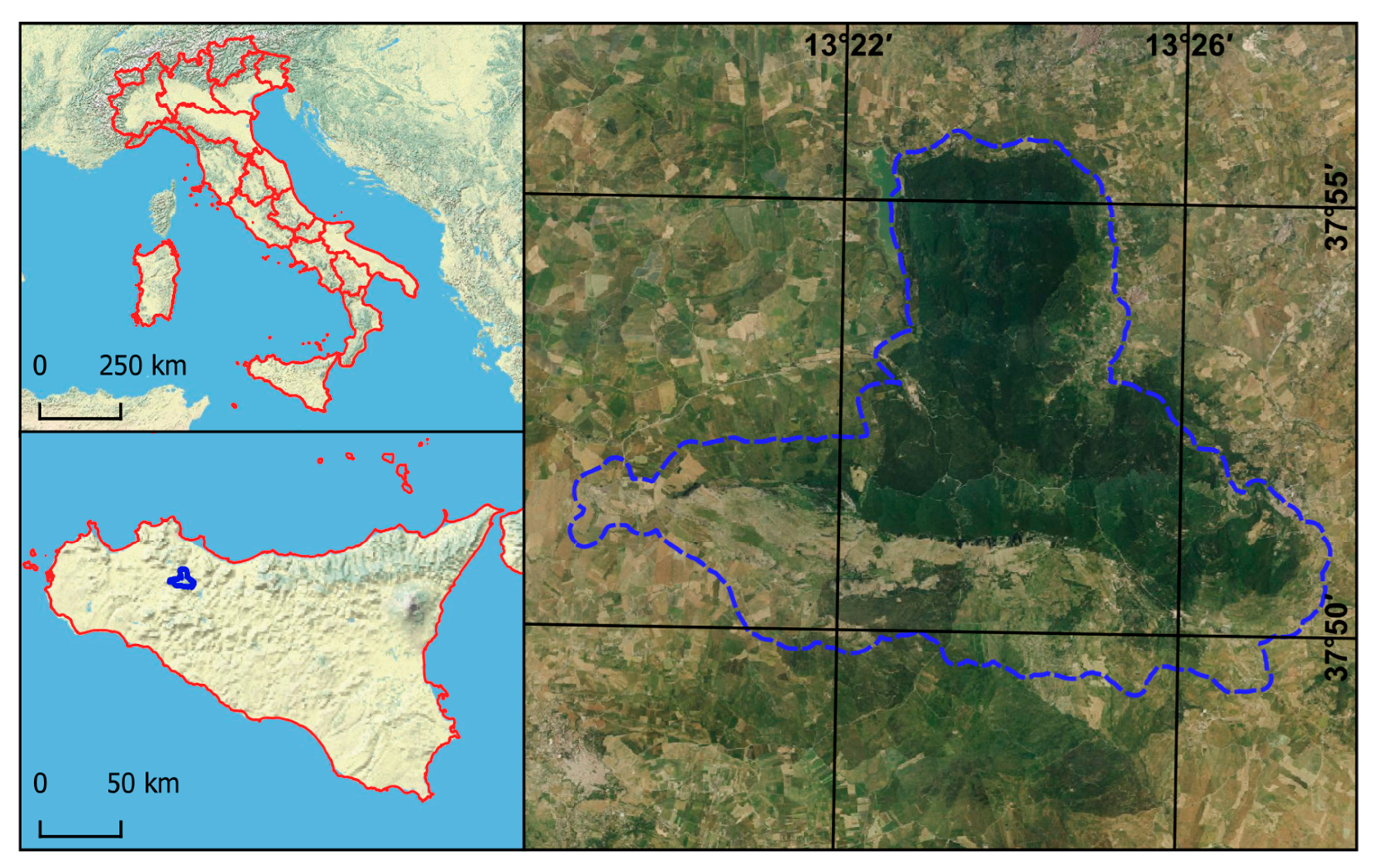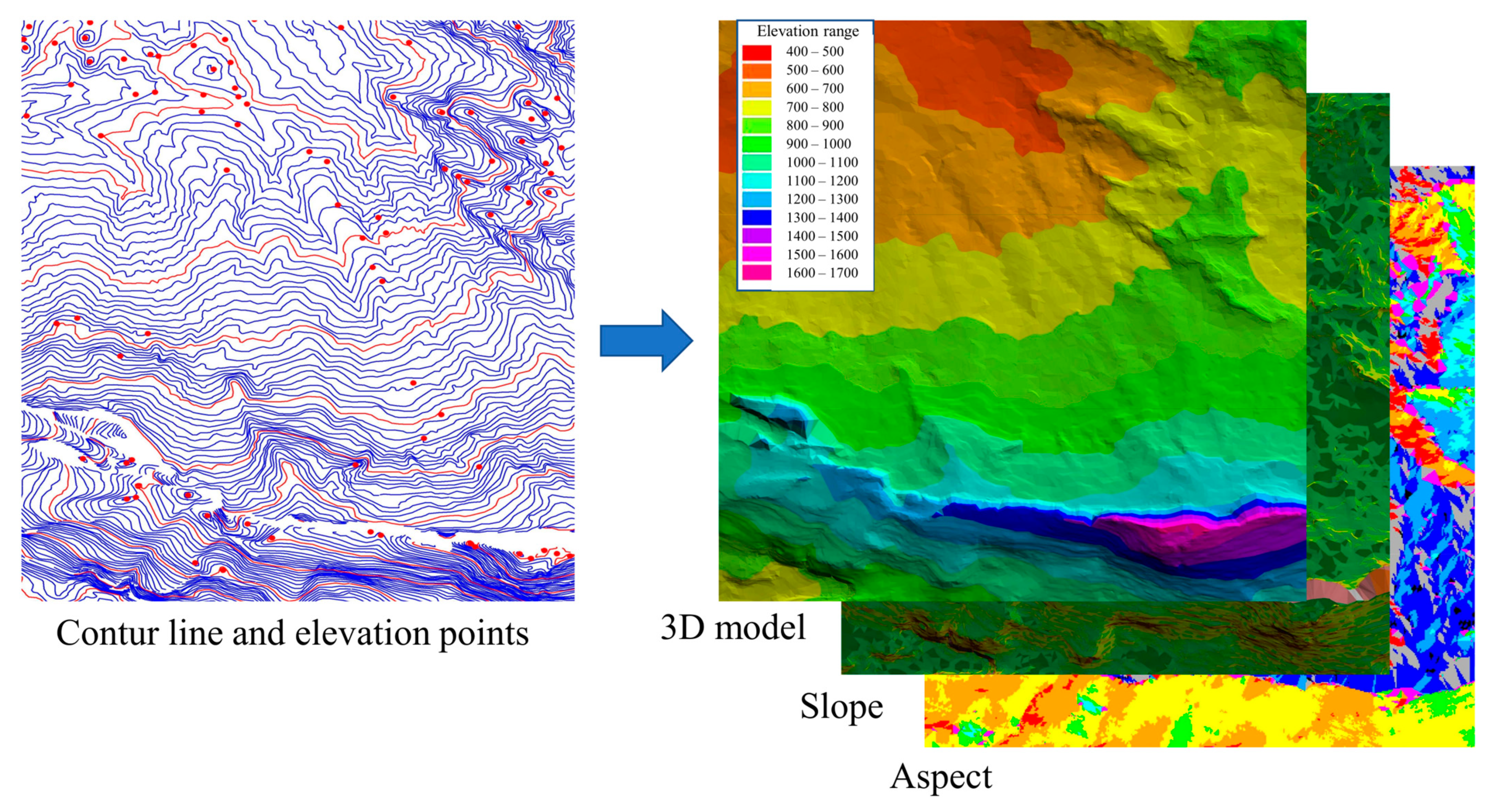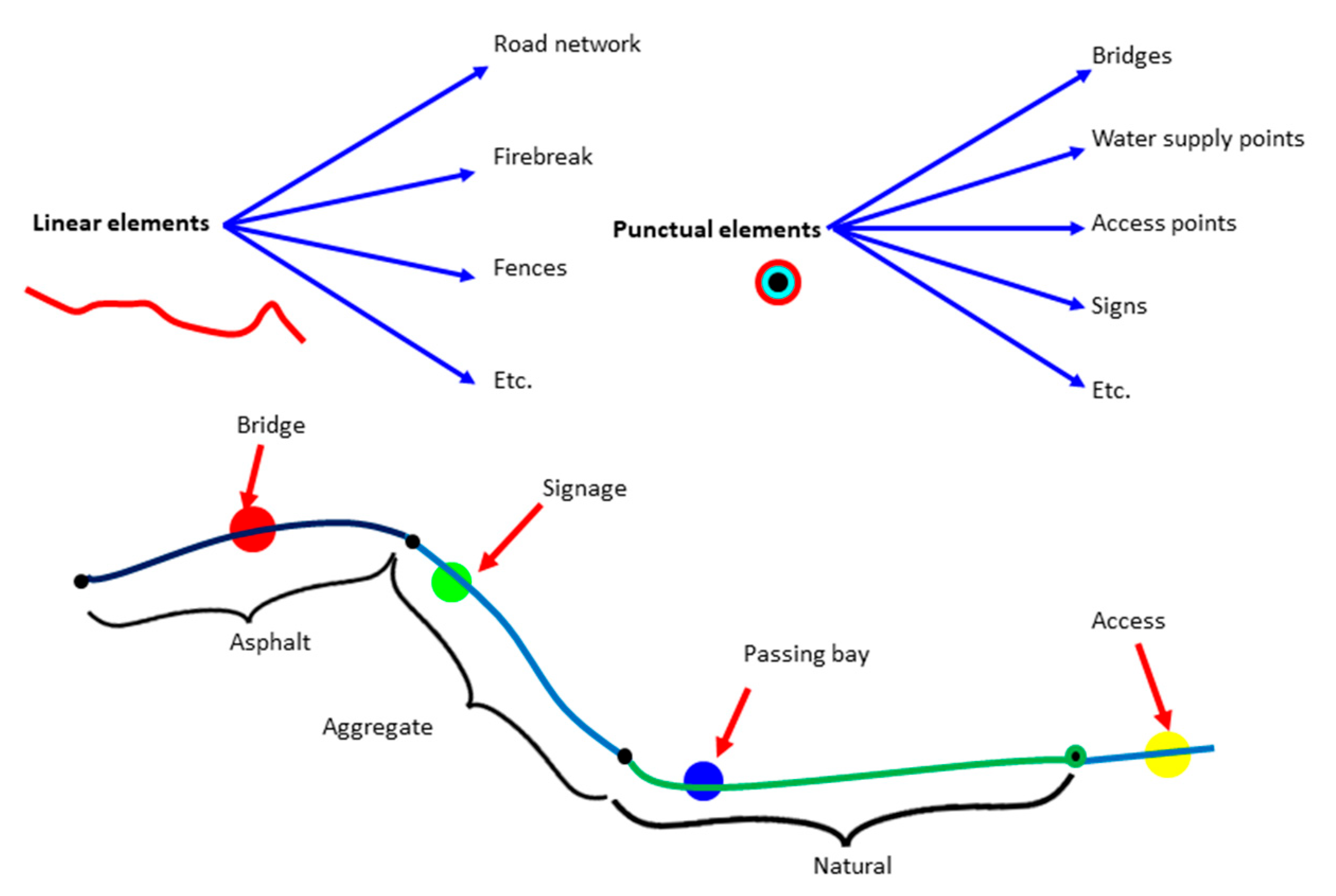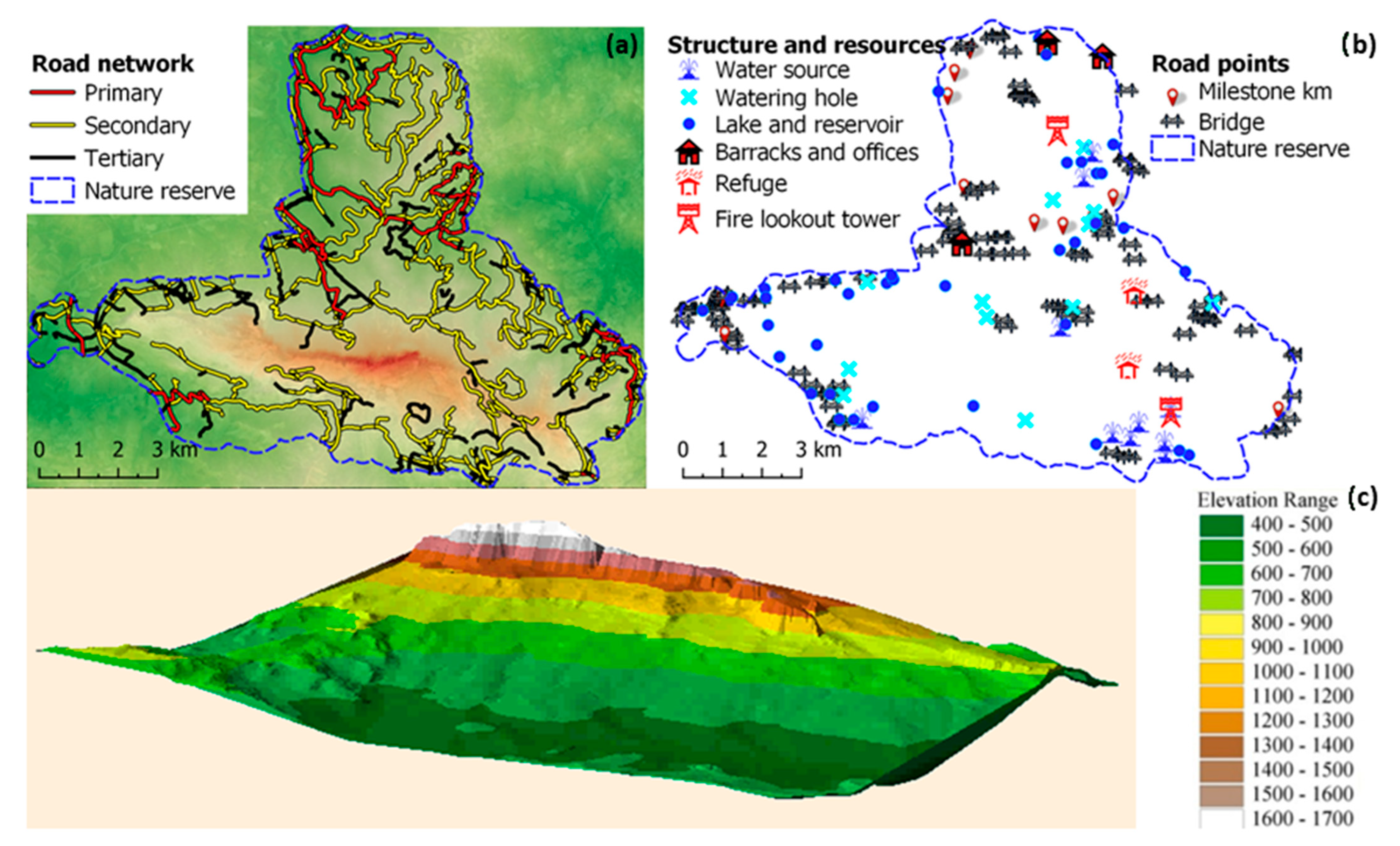Development of a GIS-Based Methodological Framework for Regional Forest Planning: A Case Study in the Bosco Della Ficuzza Nature Reserve (Sicily, Italy)
Abstract
1. Introduction
2. Materials and Methods
2.1. Study Area
2.2. Cartographic and Geospatial Data Sources
2.3. GIS and Spatial Analysis Workflow
2.4. Road Infrastructure Survey
3. Results
3.1. Digital Terrain Model and Thematic Layers
3.2. Forest Road Inventory and Accessibility Analysis
3.3. Integration into a GIS-Based Territorial Information System
4. Discussion
4.1. Significance of Topographic and Terrain Analysis
4.2. Road Network Assessment and GNSS Applications
4.3. Replicability and Scalability of the GIS-Based Framework
4.4. Institutional Implications and Capacity Building
5. Conclusions
Author Contributions
Funding
Data Availability Statement
Conflicts of Interest
References
- Tiebel, M.; Mölder, A.; Plieninger, T. Conservation Perspectives of Small-Scale Private Forest Owners in Europe: A Systematic Review. Ambio 2022, 51, 836–848. [Google Scholar] [CrossRef] [PubMed]
- Di Benedetto, S. Innovative Forest Multiscale Management and Planning: Modelling and Mapping Tools to Monitor Forest Ecosystems Functionality. Ph.D. Thesis, Università Degli Studi Della Tuscia, Viterbo, Italy, 2018. [Google Scholar]
- Rye, T.; Wretstrand, A. Swedish and Scottish National Transport Policy and Spend: A Social Equity Analysis. Sustainability 2019, 11, 1894. [Google Scholar] [CrossRef]
- Nyamushosho, R.T.; Chirikure, S.; Sitas, A.; Maṱhoho, E.N. Modelling Land Use in the Gold Belt Territories of Iron Age Southern Zambezia. Land 2022, 11, 1425. [Google Scholar] [CrossRef]
- Valjarević, A.; Djekić, T.; Stevanović, V.; Ivanović, R.; Jandziković, B. GIS numerical and remote sensing analyses of forest changes in the Toplica region for the period of 1953–2013. Appl. Geogr. 2018, 92, 131–139. [Google Scholar] [CrossRef]
- Abad-Segura, E.; González-Zamar, M.-D.; Vázquez-Cano, E.; López-Meneses, E. Remote Sensing Applied in Forest Management to Optimize Ecosystem Services: Advances in Research. Forests 2020, 11, 969. [Google Scholar] [CrossRef]
- Sferlazza, S.; Maltese, A.; Ciraolo, G.; Dardanelli, G.; Maetzke, F.G.; La Mela Veca, D.S. Forest Accessibility, Madonie Mountains (Northern Sicily, Italy): Implementing a GIS Decision Support System. J. Maps 2021, 17, 476–485. [Google Scholar] [CrossRef]
- Pipitone, C.; Maltese, A.; Lo Brutto, M.; Dardanelli, G. A Review of Selected Applications of GNSS CORS and Related Experiences at the University of Palermo (Italy). Remote Sens. 2023, 15, 5343. [Google Scholar] [CrossRef]
- Civitarese, V.; Pignatti, G.; Verani, S.; Sperandio, G. Pianificazione Delle Operazioni Di Esbosco in Un Ceduo. For. J. Silvic. For. Ecol. 2006, 3, 367. [Google Scholar]
- Rogan, J.; Miller, J.; Wulder, M.; Franklin, S. Integrating GIS and Remotely Sensed Data for Mapping Forest Disturbance and Change. In Understanding Forest Disturbance and Spatial Pattern: Remote Sensing and GIS Approaches; CRC Press: Boca Raton, FL, USA, 2006; pp. 133–171. [Google Scholar] [CrossRef]
- Orlando, S.; Catania, P.; Greco, C.; Ferro, M.V.; Vallone, M.; Scarascia Mugnozza, G. Rural Landscape Transformation and the Adaptive Reuse of Historical Agricultural Constructions in Bagheria (Sicily): A GIS-Based Approach to Territorial Planning and Representation. Sustainability 2025, 17, 6291. [Google Scholar] [CrossRef]
- Orlando, S.; Greco, C.; Tuttolomondo, T.; Leto, C.; Cammalleri, S.; La Bella, S. Identification of Energy Hubs for the Exploitation of Residual Biomass in an Area of Western Sicily. In Proceedings of the EUBCE 2017 Online Conference Proceedings, Stockholm, Sweden, 12–15 June 2017. [Google Scholar] [CrossRef]
- Maimaitijiang, M. Multimodal Remote Sensing Data Fusion and Machine Learning for Crop Monitoring and Food Security. Bachelor’s Thesis, Saint Louis University, St. Louis, MO, USA, 2020. [Google Scholar]
- Di Letizia, G.; De Lucia, C.; Pazienza, P.; Cappelletti, G.M. Forest Bioeconomy at Regional Scale: A Systematic Literature Review and Future Policy Perspectives. For. Policy Econ. 2023, 155, 103052. [Google Scholar] [CrossRef]
- Da Silveira Bueno, R.; La Mantia, T. Pattern e Driver Spaziali e Temporali Della Successione Secondaria in Un Pascolo Nelle Aree Aperte Della Riserva Naturale Di Ficuzza e Prospettive Di Gestione Del Paesaggio. In Atti del Convegno Nazionale SIEP—IALE “I Paesaggi Italiani Verso il 2030: Identità, Cura e Prospettive”; IRIS: Palermo, Italy, 2021; p. 9. [Google Scholar]
- Burrough, P.A.; McDonnell, R.A.; Lloyd, C.D. Principles of Geographical Information Systems; Oxford University Press: Oxford, UK, 2015; ISBN 0-19-874284-3. [Google Scholar]
- Govers, G.; Giménez, R.; Van Oost, K. Rill Erosion: Exploring the Relationship between Experiments, Modelling and Field Observations. Earth-Sci. Rev. 2007, 84, 87–102. [Google Scholar] [CrossRef]
- Ogryzek, M.; Tarantino, E.; Rząsa, K. Infrastructure of the Spatial Information in the European Community (INSPIRE) Based on Examples of Italy and Poland. ISPRS Int. J. Geo-Inf. 2020, 9, 755. [Google Scholar] [CrossRef]
- Wilson, J.P.; Gallant, J.C. Terrain Analysis: Principles and Applications; John Wiley & Sons: Hoboken, NJ, USA, 2000; ISBN 0-471-32188-5. [Google Scholar]
- Catania, P.; Comparetti, A.; Febo, P.; Morello, G.; Orlando, S.; Roma, E.; Vallone, M. Positioning Accuracy Comparison of GNSS Receivers Used for Mapping and Guidance of Agricultural Machines. Agronomy 2020, 10, 924. [Google Scholar] [CrossRef]
- Haklay, M.; Weber, P. Openstreetmap: User-Generated Street Maps. IEEE Pervasive Comput. 2008, 7, 12–18. [Google Scholar] [CrossRef]
- Zandbergen, P.A. Geocoding Quality and Implications for Spatial Analysis. Geogr. Compass 2009, 3, 647–680. [Google Scholar] [CrossRef]
- Heinimann, H.R. Forest road network and transportation engineering–state and perspectives. Croat. J. For. Eng. J. Theory Appl. For. Eng. 2017, 38, 155–173. [Google Scholar]
- Rota, N. Evaluation of Ecosystem Services in Mountain Protected Areas: A Multi-Method Comparative Study. Ph.D. Thesis, University of Bari Aldo Moro, Bari, Italy, 2024. [Google Scholar]
- Gumus, S.; Acar, H.H.; Toksoy, D. Functional Forest Road Network Planning by Consideration of Environmental Impact Assessment for Wood Harvesting. Environ. Monit. Assess. 2008, 142, 109–116. [Google Scholar] [CrossRef] [PubMed]
- Moreira, F.; Viedma, O.; Arianoutsou, M.; Curt, T.; Koutsias, N.; Rigolot, E.; Barbati, A.; Corona, P.; Vaz, P.; Xanthopoulos, G. Landscape–Wildfire Interactions in Southern Europe: Implications for Landscape Management. J. Environ. Manag. 2011, 92, 2389–2402. [Google Scholar] [CrossRef]
- Borghi, C.; Chirici, G. Towards Biodiversity Conservation Goals: Remote Sensing and Ground-Based Data Applied to the Assessment of Forest Status. Ph.D. Thesis, Università di Firenze, Florence, Italy, 2024. [Google Scholar]
- McCall, M.K.; Minang, P.A. Assessing Participatory GIS for Community-based Natural Resource Management: Claiming Community Forests in Cameroon. Geogr. J. 2005, 171, 340–356. [Google Scholar] [CrossRef]
- Bettinger, P.; Boston, K.; Siry, J.P.; Grebner, D.L. Forest Management and Planning; Academic Press: Cambridge, MA, USA, 2016; ISBN 0-12-809706-X. [Google Scholar]
- Corona, P.; Chianucci, F.; Quatrini, V.; Civitarese, V.; Clementel, F.; Costa, C.; Floris, A.; Menesatti, P.; Puletti, N.; Sperandio, G. Precision Forestry: Riferimenti Concettuali, Strumenti e Prospettive Di Diffusione in Italia. For. J. Silvic. For. Ecol. 2017, 14, 1–12. [Google Scholar] [CrossRef]
- EEA Report European Environment Agency. State of Nature in the EU: Results from Reporting under the Nature Directives 2013–2018; EEA Report European Environment Agency: Copenhagen, Denmark, 2020. [Google Scholar]
- Jokela, E.J. Forests: An International and Multi-Disciplinary Scientific Open Access Journal. Forests 2010, 1, 1–3. [Google Scholar] [CrossRef]




| Aspect | Existing Approaches | Proposed Framework |
|---|---|---|
| Scope | Sectoral focus (wildfire risk, biodiversity, infrastructure) [6,7] | Integrated multi-layered Territorial Information System (TIS) |
| Data Integration | Limited integration between field surveys and cartography | Fusion of GNSS-based field surveys, high-resolution topography, and thematic mapping |
| Governance Adaptability | Weak consideration of multi-level governance complexities | Tailored to Mediterranean protected areas, adaptable to fragmented governance structures |
| Planning Approach | Static, non-participatory [8,9,10] | Adaptive, participatory, and replicable |
| Transferability | Context-specific, limited scalability | Scalable and replicable model for other Mediterranean forest ecosystems |
| Road Network | Punctual Element | |||
|---|---|---|---|---|
| Parameter | Value | Element | Type | Condition |
| Road surface | Asphalt | Bridge | Wood | Excellent Good Mediocre Poor |
| Aggregate | Concrete | |||
| Improved | Steel | |||
| Natural | Mixed | |||
| Transitability | Excellent | Signage | Road | |
| Good | Reserve zones | |||
| Mediocre | Trails | |||
| Poor | Information | |||
| Width | Minimum | Forest Infrastructure | Fire lookout tower | |
| Medium | Shelter | |||
| Canopy interference | Yes | Storage | ||
| No | Other | |||
| Routes, Road Element and Density | Structure and Resources | |||
|---|---|---|---|---|
| Primary roads | 55 km | 6.4 m ha−1 | Water source (no) | 12 |
| Secondary roads | 104 km | 12.2 m ha−1 | Watering hole (no) | 14 |
| Tertiary road | 84 km | 9.9 m ha−1 | Lake and reservoir (no) | 36 |
| Pathway | 41 km | 4.8 m ha−1 | Barracks and offices (no) | 4 |
| Milestone (no) | 11 | Refuge (no) | 6 | |
| Bridge (no) | 102 | Fire lookout tower (no) | 3 | |
Disclaimer/Publisher’s Note: The statements, opinions and data contained in all publications are solely those of the individual author(s) and contributor(s) and not of MDPI and/or the editor(s). MDPI and/or the editor(s) disclaim responsibility for any injury to people or property resulting from any ideas, methods, instructions or products referred to in the content. |
© 2025 by the authors. Licensee MDPI, Basel, Switzerland. This article is an open access article distributed under the terms and conditions of the Creative Commons Attribution (CC BY) license (https://creativecommons.org/licenses/by/4.0/).
Share and Cite
Orlando, S.; Catania, P.; Ferro, M.V.; Greco, C.; Modica, G.; Mammano, M.M.; Vallone, M. Development of a GIS-Based Methodological Framework for Regional Forest Planning: A Case Study in the Bosco Della Ficuzza Nature Reserve (Sicily, Italy). Land 2025, 14, 1744. https://doi.org/10.3390/land14091744
Orlando S, Catania P, Ferro MV, Greco C, Modica G, Mammano MM, Vallone M. Development of a GIS-Based Methodological Framework for Regional Forest Planning: A Case Study in the Bosco Della Ficuzza Nature Reserve (Sicily, Italy). Land. 2025; 14(9):1744. https://doi.org/10.3390/land14091744
Chicago/Turabian StyleOrlando, Santo, Pietro Catania, Massimo Vincenzo Ferro, Carlo Greco, Giuseppe Modica, Michele Massimo Mammano, and Mariangela Vallone. 2025. "Development of a GIS-Based Methodological Framework for Regional Forest Planning: A Case Study in the Bosco Della Ficuzza Nature Reserve (Sicily, Italy)" Land 14, no. 9: 1744. https://doi.org/10.3390/land14091744
APA StyleOrlando, S., Catania, P., Ferro, M. V., Greco, C., Modica, G., Mammano, M. M., & Vallone, M. (2025). Development of a GIS-Based Methodological Framework for Regional Forest Planning: A Case Study in the Bosco Della Ficuzza Nature Reserve (Sicily, Italy). Land, 14(9), 1744. https://doi.org/10.3390/land14091744











